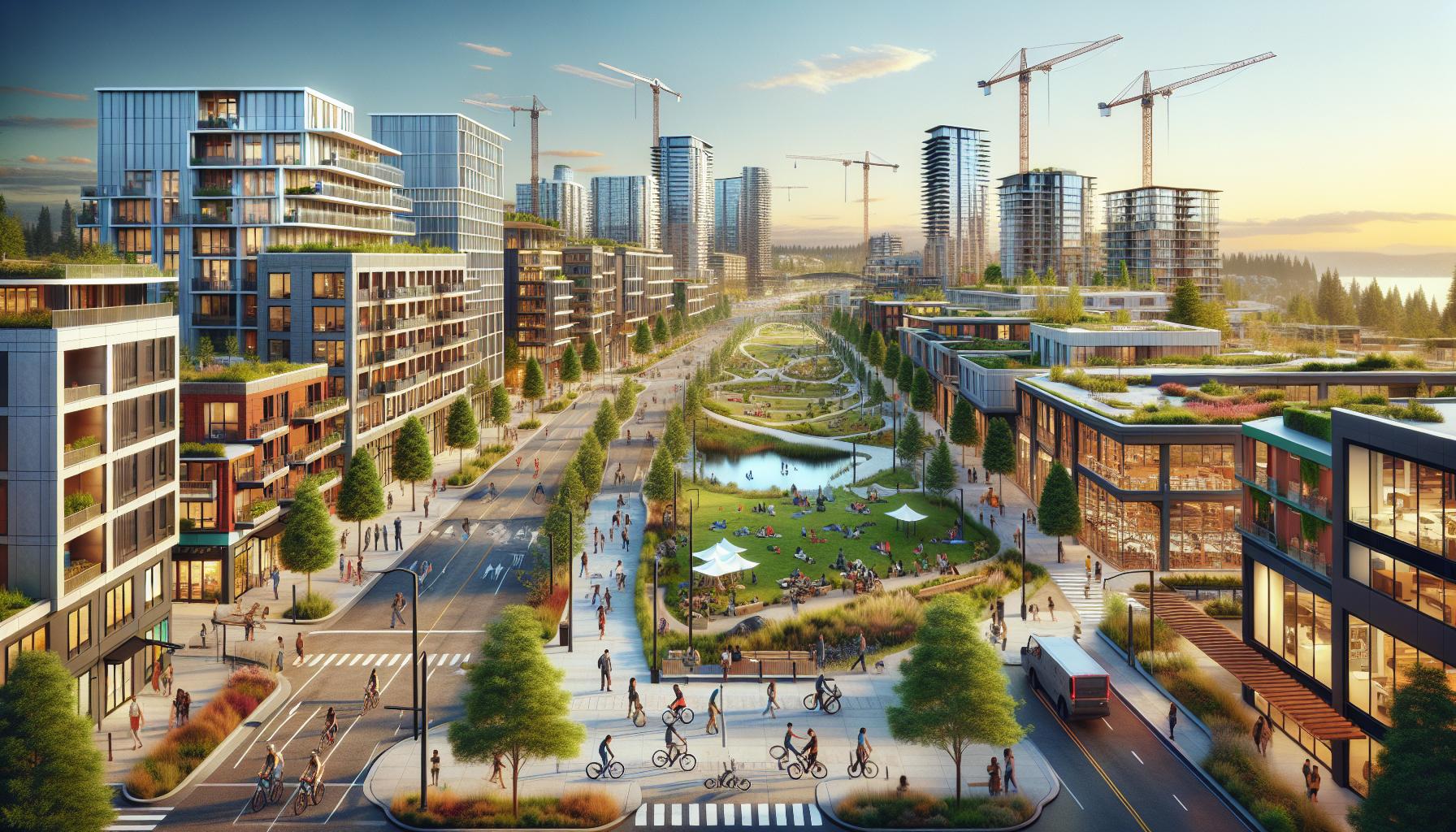Strap in, folks, because we’re about to embark on a journey through the dynamic landscape of Kirkland’s development. It’s a tale of transformation, of a city that’s not just growing, but evolving, building a future that’s as bright as its past is rich.
From its humble beginnings to its current burgeoning state, Kirkland’s story is one of resilience and innovation. We’ll be diving into the heart of this city’s development, exploring the forces that have shaped it and the visionaries who are steering it towards a promising future.
So, whether you’re a long-time resident or a curious outsider, there’s something for everyone in this fascinating exploration. Let’s get started, shall we?
Understanding Kirkland’s Development: Building a Future
Let’s delve deeper into the building blocks of this remarkable journey of change.
Kirkland’s Historical Background
With its origins traced back to 1888, Kirkland was once just a ferry town. Surrounded by verdant greenery, it had vast logs transported down Lake Washington. A source of fascination is the local wool mill, a major employer that set the town humming in the early 20th century. Progress did not stop here; post World War II, Kirkland began to evolve, fueled by expansions of the technology industry and growing residential demands. Moving away from logging and milling, Kirkland slowly but surely established itself as a livable and desirable location.
Evolution of Kirkland’s Development Plans
From the mid-20th century onwards, a slew of development plans began to shape Kirkland’s identity. Firstly, the Comprehensive Plan, presented in the ’60s, aimed at diversified development, promoting balance among commercial, residential, and recreational spaces. Followed by the Growth Management Act in 1990, it emphasized preserving Kirkland’s environment while accommodating metropolitan growth. The recent, 2035 Comprehensive Plan further demonstrates the commitment to create a sustainable, inclusive, and vibrant urban environment for residents. Each of these plans played a vital role in orchestrating the city we know as Kirkland today.
Unpacking Kirkland’s Current Projects
Let’s delve deeper into Kirkland’s future by examining its current infrastructure projects and construction plans. These endeavors embody the city’s mission to provide sustainable and inclusive growth.
Key Infrastructure Developments
Kirkland’s thriving development landscape is punctuated by significant infrastructure projects. One such project is the Multi-Purpose Snoqualmie Integrated Sites Plan, designed for resource support, from water, sewer, and storm facilities to parks and green spaces. Moreover, the Finn Hill Neighborhood Plan, geared towards improving transportation, parks, and land use, exemplifies Kirkland’s dedication to developing vibrant, inclusive communities.
Besides, there’s the Everest Neighborhood Plan, focusing on public realm advancements, like traffic calming, pathways, parks, and open spaces. Interestingly, the Kirkland Transit Implementation Plan represents the city’s commitment to forging a transportation system catered to diverse mobility needs.
Residential and Commercial Construction Projects
Residential and commercial projects equally champion Kirkland’s vision for balanced growth. For example, Market Street Village, a mixed-use project, integrates residential, retail, and recreational spaces in a harmonious blend of community engagement and urban living. Similarly, the Village at Totem Lake is a testament to the city’s embrace of commercial growth, featuring a retail space, luxury apartments, and recreational facilities.
On the residential front, the Juanita Apartments project aims to provide affordable, quality housing for a range of incomes, highlighting the city’s commitment to inclusivity. Other projects, like the Carlyle’s luxury condominiums and The Walk’s modern townhomes, cater to a variety of lifestyle preferences, further enriching Kirkland’s residential landscape.
Both these broad categories of infrastructure and construction work symbolize Kirkland’s stride towards a resilient, sustainable future. And as we continue to delve into Kirkland’s journey, we see its robust vision coming to life in the cityscape.
Kirkland’s Environment-friendly Approach
Bearing its futuristic vision, Kirkland promotes an environment-friendly approach, emphasizing green practices and renewables. Here’s a look at some initiatives transforming Kirkland into a model of sustainable living.
Promoting Green Building Practices
In the journey of building a future, I find Kirkland’s adaption of green building practices remarkable. Adopted extensively, these practices prioritize using sustainable construction materials, such as reclaimed wood or recycled metal. For instance, the Slough Restoration Project involved utilizing eco-friendly materials to reestablish the estuary habitat, proving Kirkland’s commitment to the environment. Moreover, many buildings adhere to LEED certification, a globally recognized symbol of sustainability achievement. This standard showcases Kirkland’s dedication to reducing construction’s environmental impact, fulfilling its mandate of eco-friendly urban planning.
Embracing Renewables and Energy Efficiency
Hand in hand with green building practices, Kirkland also embraces renewables and energy efficiency. A shining example is the adoption of solar power – Kirkland’s significant investment. Through programs like Solarize Kirkland, residents can install solar panels at a reduced cost, fostering a community-wide transition to clean energy. Not stopping there, the city encourages energy efficiency through actions such as retrofitting public buildings to conserve energy and implementing LED street light conversions. Hence, in its path to the future, Kirkland shows its commitment to renewables, making strides towards sustainability.
Evaluating the Economic Impact of Kirkland’s Development
Kirkland’s growth holds extensive implications for the city’s economy. We’ll delve into the employment opportunities created by this development and how the city attracts businesses and investments.
Employment Opportunities Arising from Kirkland’s Development
Kirkland’s economic development significantly fuels job growth in the area. Rapid expansion in sectors like technology, construction, and retail has diversely increased employment prospects. For instance, the proliferation of tech companies like Google and GoDaddy has led to a surge in tech jobs, attracting skilled professionals to the city.
Moreover, ongoing construction projects, like the Snoqualmie Integrated Sites Plan and Market Street Village, not only provide immediate employment for construction workers but also hold promise for future job growth in retail and service sectors linked to these developments. These projects exemplify Kirkland’s dedication to promoting a strong local labor market, which is an integral part of a resilient and prosperous community.
Attracting Businesses and Investments in Kirkland
In addition to job creation, Kirkland’s appealing environment and robust infrastructure attract many businesses. Its thriving economy, strategic location, and excellent connectivity make it a desirable destination for enterprises looking to invest or expand.
Take the case of Google, which has chosen Kirkland as the location for its second-largest engineering center, lured by the city’s talent pool and quality of life. Small businesses like Cafes and local boutiques are also thriving, given the increased footfall from residents and tourists alike.
Through attractive incentives, like lower taxes and streamlined permitting processes, Kirkland fosters a conducive business environment. Programs like Solarize Kirkland hold particular appeal for environment-conscious businesses, positioning the city as a national leader in sustainability. Therefore, Kirkland shows a unique capacity to attract diverse businesses and investments, contributing significantly to its flourishing economy.
Kirkland’s Development: The Community Perspective
Given Kirkland’s remarkable evolution, it’s critical to consider the experiences and aspirations of the many who call this city home. This section delves deeper into the heart of community involvement and social equity in Kirkland’s development.
The Role of Community Involvement
In Kirkland’s growth narrative, the community’s role can’t be understated. Active civic participation, from public consultations on new developments to citizen-led initiatives, has been central to shaping Kirkland’s future. For instance, resident feedback factored significantly in the Finn Hill Neighborhood Plan, ensuring a development process that respects and incorporates local values. Likewise, numerous community events, like Kirkland Wednesday Market, showcase the strong sense of belonging among residents while fostering unity and enhancing their connection to the city. Through these varied initiatives, members of the community actively participate in Kirkland’s story, helping weave the city’s shared future.
Addressing Housing and Social Equity in Development
Equally pivotal in Kirkland’s growing narrative is the emphasis on housing and social equity. Kirkland’s success isn’t simply marked by impressive infrastructure and economic advancements but also by its commitment to inclusiveness. The city’s ambitious affordable housing strategy, with projects like Market Street Village and Juanita Apartments, exemplifies this approach, serving as a testament to its dedication towards housing equity. In a move towards social justice, the city has also launched an Equity Gap Analysis and Action Plan for internal operations, reinforcing the importance of fairness in its development plans. These actions mark a critical step in aligning Kirkland’s progress with the wider goal of social equity, fostering a more inclusive city for all.
Prospects of Kirkland’s Future Development
Kirkland’s ongoing journey of growth and innovation is a saga that never ceases to dazzle. As I delve deeper, let’s shed light on possible avenues for future development and potential challenges in the city’s path.
Planning for Sustainable Growth
Kirkland’s commitment to a thriving, inclusive future is encapsulated in its approach to sustainable growth. The city understands the significance of coordinating urban development with environmental needs, and it’s here where innovative practices such as green construction and LEED certification projects come into play.
My focus then shifts to the city’s energy policies. Many Kirkland initiatives prioritize the use of renewable energy sources, encouraging residents to integrate solar panels into their homes via programs like Solarize Kirkland. This not only conserves resources but also sets an example for cities around the world.
Balancing growth with inclusivity, Kirkland has shown a remarkable commitment to developing affordable housing strategies and social initiatives like the Equity Gap Analysis and Action Plan. By ensuring all residents share in the city’s success, Kirkland is laying the groundwork for a future that is inherently sustainable, inclusive, and resilient.
Anticipating Challenges and Solutions
Despite its optimism, Kirkland remains cognizant of potential roadblocks to its grand vision. Economic expansions, while promising, may exacerbate issues like income disparities and gentrification, making it challenging for lower-income residents to live in the city.
Kirkland, however, is not deterred and instead faces these challenges head-on. For example, the city is exploring diverse solutions like bolstering public transit to counter potential traffic congestion stemming from growth. It’s also doubling down on affordable housing policies to ensure that people from diverse economic backgrounds can continue to call Kirkland home.
Additionally, the city’s commitment to open dialogue encourages citizens to voice their concerns and offer suggestions, paving the way for collective problem-solving. The well-attended Kirkland Wednesday Market and similar events underline the crucial role of community involvement in future-proofing this dynamic city.
Looking ahead, Kirkland’s prospects shine bright. Fueled by resilience and innovation, this city is not just building structures; it’s constructing a future that holds promise for all.
Conclusion
It’s evident that Kirkland’s journey from a small ferry town to a bustling city has been nothing short of remarkable. Its resilience and innovative spirit shine through, from the rise of the tech industry to the adoption of green building practices. The city’s commitment to balanced growth is commendable, with ongoing projects and future plans all tailored towards sustainability and inclusivity.
Kirkland’s eco-friendly initiatives, like Solarize Kirkland, are setting the standard for cities nationwide. Its thriving economy, driven by diverse sectors and attractive to businesses, is a testament to its strategic development. The city’s focus on social equity and community involvement ensures that everyone can partake in its success.
As Kirkland looks to the future, it’s clear that it’s not just building infrastructure, but a community that’s resilient, inclusive, and sustainable. It’s a city that’s not just growing, but evolving, ensuring a promising future for all its residents.





0 Comments